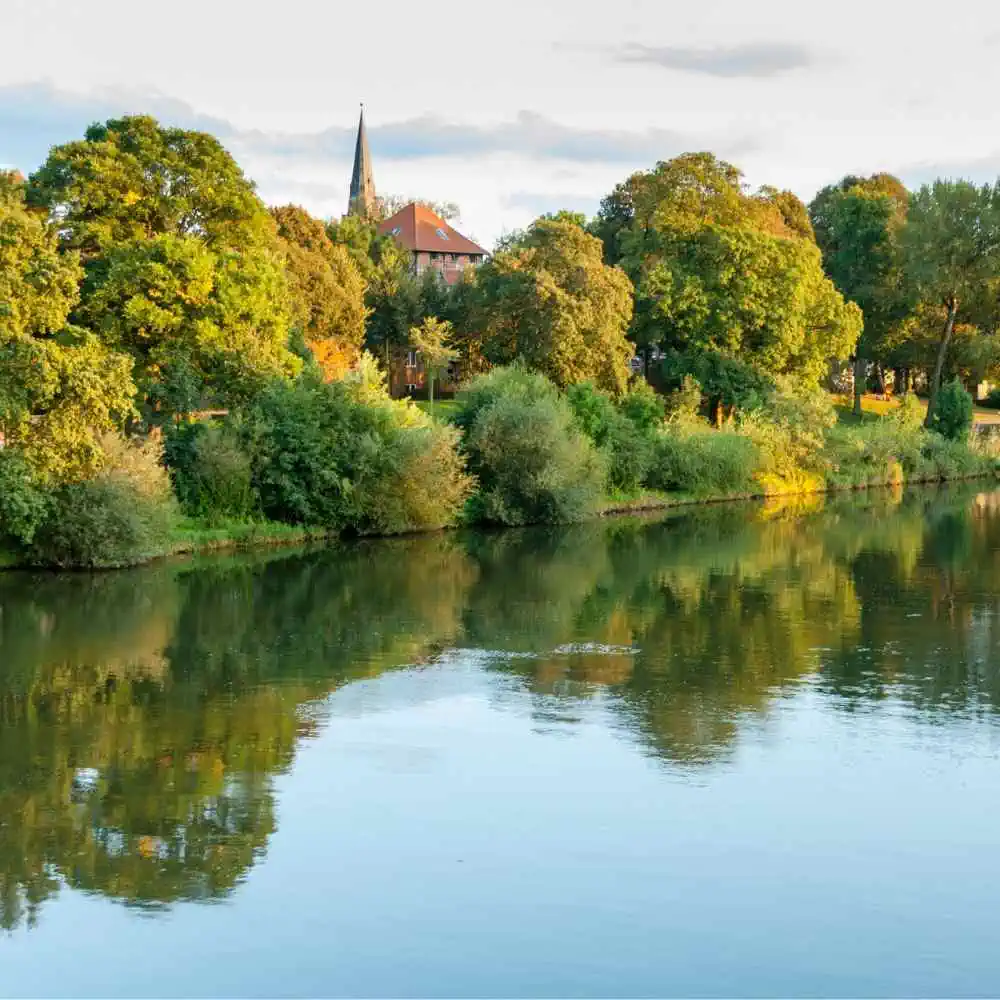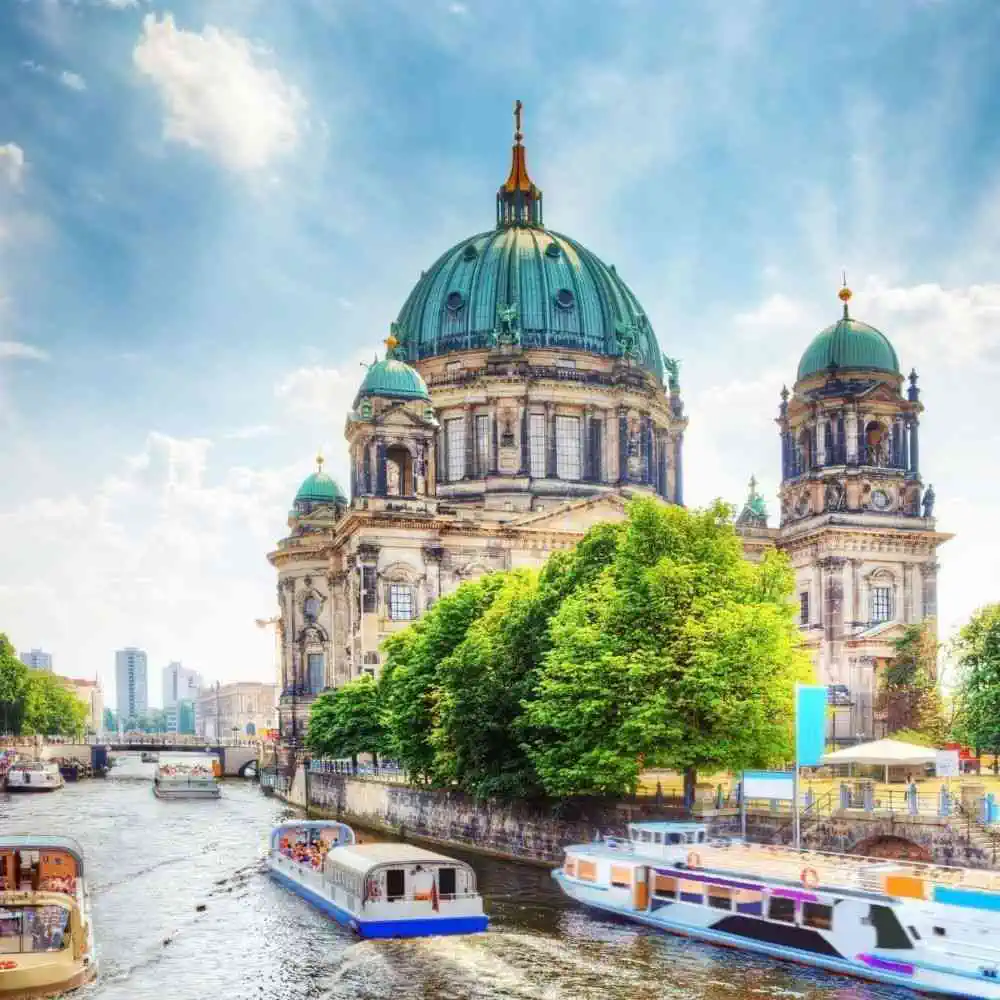Partirai da Nienburg (Weser), situata proprio nel centro della città di Nienburg, e godrai del bellissimo paesaggio del viaggio mentre arrivi a Berlino Stazione Centrale, situata anche essa nel cuore di Berlino.
Treni da Nienburg a Berlinoda € 75.00
Treni da Nienburg a Berlino
Viaggiare in treno: Nienburg - Berlino
Are you looking to explore Germany in all its glory? Then look no further than a journey from Nienburg to Berlin. This journey spans a distance of about 243 km across six different railway stations, taking around four hours. From the old city of Nienburg, to the vibrant modern metropolis of Berlin, this journey brings together the best of German culture – historic sightseeing, cultural exploration, and a look at the country's incredible landscape.
The railway stations along the way include Verden, Bremen, Lehrte, Uelzen, Wittenberge and, of course, Berlin's Hauptbahnhof. These stations offer plenty of opportunities for sightseeing and exploring the area's attractions. For instance, while in Verden, you can explore the Verden Cathedral, a stunningly beautiful 12th century church. In Lehrte, you can visit the Lehrter Fußgängerzone, a historic pedestrian zone with a variety of shops, restaurants, and attractions. And while in Berlin, you can visit the Brandenburg Gate, the Reichstag building, and the Berlin Wall – all extraordinary sites full of history and culture.
Along the way, you'll also be able to take in the scenery of Germany's vast countryside. From the wooded terrain of the Lower Saxony, to the rolling hills of the eastern state of Brandenburg, you'll encounter a variety of landscapes that will keep your eyes glued to the window. Also, you won't want to forget to take in the fascinating sights that Nienburg and Berlin have to offer.
So if you're looking for a journey through time and space, a trip from Nienburg to Berlin is your perfect destination. Whether you're there to see the sights, explore the culture, or simply take in the scenery, this journey has something for everyone. And when you arrive in Berlin, don't forget to pick up a Berlin Bear as a souvenir – a plush toy symbolizing the city's place in history as one of the world's most vibrant metropolises.
Discover the beauty of Germany on a journey from Nienburg to Berlin – a trip that will take you through time and space, and immerse you in a world of culture, history, and breathtaking scenery.

Dettagli del viaggio
How long does the train from Nienburg to Berlin take?
The journey time for trains from Nienburg to Berlin varies, but on average, it takes approximately 2 hours and 30 minutes.
What is the fastest journey from Nienburg to Berlin by train?
The fastest train journey from Nienburg to Berlin can be around 2 hours and 20 minutes under optimal conditions.
How much does the train cost from Nienburg to Berlin?
Prices for a train ticket from Nienburg to Berlin start from approximately €30, but can vary based on booking time and class.
How much does the Nienburg to Berlin?
No, there are no direct trains from Nienburg to Berlin; at least one change is necessary.
What is the distance from Nienburg to Berlin by train?
The distance from Nienburg to Berlin by train is approximately 300 Km.
Which are the cities that the train stops from Nienburg to Berlin?
The train from Nienburg to Berlin typically stops in key cities including Hannover, Wolfsburg, and sometimes Stendal depending on the route taken.
Acquista biglietti del treno da Nienburg a Berlino
Viaggiare in treno da Nienburg a Berlino è un viaggio facile e confortevole. RailClick è il modo migliore per viaggiare in Europa in treno.
Nienburg: Luoghi da visitare
Nienburg is a city in Lower Saxony, Germany that is steeped in history and full of architectural wonders. From its majestic cathedrals to its quaint cobblestone streets, it’s the perfect place to explore and experience Germany’s medieval past. Here are 7 must-visit historical and architectural sites in Nienburg.
Städtisches Museum: Located in the city center, the museum holds exhibitions and collections dedicated to the history and culture of Nienburg. From its impressive architecture to its interactive exhibits, the museum is a great way to immerse yourself in the city’s rich history. Opening times and entrance fees vary, and there is free entry for children. Insider tip: Be sure to try the Clock Tower, a simulated walk through the city across different time periods.
Old Town Hall: Located in the heart of the city, the Old Town Hall is an impressive building and a symbol of Nienburg. It is characterized by its baroque architecture and intricate frescoes, its iconic clock tower and its historical plaques. The hall is free to visit and is open daily from 9am to 5pm.
Cathedral of St. Mary: One of the most iconic landmarks in the city, the Cathedral of St. Mary is one of the oldest and most beautiful churches in Lower Saxony. Its impressive baroque and gothic architecture, gorgeous frescoes and colorful stained glass windows make it a must-visit for any history or architecture buffs. Entrance is free and opening times vary.
Doktorhaus: Located near the St. Mary Cathedral, the Doktorhaus is the oldest residential building in Nienburg and is a great example of German vernacular architecture. Visitors can explore its unique history and visit the unique collections it houses. Entrance fees vary and opening times are Monday to Friday from 8am to 5pm.
Schloß Nienburg: A beautiful castle located on the banks of the Weser, Schloß Nienburg is a spectacular example of German architecture. Visitors can explore the castle’s rich history and take in its stunning architecture. Entrance is free and opening times vary.
Dietrich-Bonhoeffer-Kirche: Located in the city center, Dietrich-Bonhoeffer-Kirche is a stunning church and a unique example of modern German architecture. Visitors can explore its unique history and take in its unique design. Entrance is free and opening times vary.
Smoked Eel: No trip to Nienburg is complete without trying the region’s famous smoked eel. You can find smoked eel all around the city, from street vendors to fine dining restaurants. It’s a tasty and traditional dish that you won’t want to miss.
From ancient castles to modern churches, Nienburg is a city that you won’t want to miss. By taking in its local culture, trying its food, and visiting its historical and architectural sites, you’ll get a unique glimpse into Germany’s past. So come and explore Nienburg and all it has to offer.

Berlino: Luoghi da visitare
Berlino, la vibrante capitale della Germania, è un crogiolo di storia, cultura e architettura moderna. Con un passato tanto tumultuoso quanto affascinante, questa città offre un incredibile viaggio attraverso i secoli, ricco di monumenti emblematici e piatti tradizionali che narrano la sua storia. Scopriamo insieme gli imperdibili tesori di Berlino!
Porta di Brandeburgo: Icona di Berlino, simbolo di pace e unità, si erge maestosa al termine dell’Unter den Linden. Un tempo parte del muro di Berlino, oggi testimonia la riunificazione della città. Ubicazione: Pariser Platz.
Memoriale del Muro di Berlino: Lungo la Bernauer Straße, questo sito offre una profonda riflessione sulla divisione della città. Include frammenti del muro, la "Death Strip" e una torre di osservazione. Ubicazione: Bernauer Straße, ingresso gratuito.
Reichstag: Famoso per la sua cupola di vetro progettata da Norman Foster, che simbolizza la trasparenza politica. È possibile visitare la cupola e godere di una vista panoramica sulla città. Ubicazione: Platz der Republik 1, prenotazione gratuita ma obbligatoria.
Isola dei Musei: Patrimonio UNESCO, accoglie cinque musei di prestigio che ospitano tesori dell'arte e della storia umana. Ubicazione: Am Lustgarten, biglietto combinato disponibile per tutti i musei.
Memoriale dell'Olocausto: Composto da 2.711 blocchi di cemento di varie altezze, offre un momento di riflessione sulle vittime dell’Olocausto. Ubicazione: Cora-Berliner-Straße 1, ingresso gratuito.
East Side Gallery: Il più lungo tratto rimasto del Muro di Berlino, trasformato in una galleria a cielo aperto con opere d'arte che celebrano la libertà. Ubicazione: Mühlenstraße, ingresso libero.
Charlottenburg Palace: Un magnifico esempio dell'architettura barocca, con splendidi giardini all'inglese. Ubicazione: Spandauer Damm 20-24, biglietto d'ingresso richiesto.
Dopo aver esplorato i tesori storici e architettonici di Berlino, immergiti nella cultura culinaria locale. Non perdere il classico Currywurst, uno snack amato dai berlinesi, o siediti in una tradizionale Biergarten per gustare una Bratwurst accompagnata da una fresca pinta di birra.
Per gli amanti delle escursioni, i dintorni di Berlino offrono deliziose sorprese, come il pittoresco Potsdam con i suoi palazzi e giardini, facilmente raggiungibile in treno per una gita di un giorno. La storia, l’arte e la cultura di Berlino aspettano solo di essere scoperte, rendendo ogni angolo di questa città un capitolo indimenticabile del tuo viaggio.

Nienburg: Principali stazioni ferroviarie
Nienburg is a city in Germany which has an important train station, Nienburg Main Train Station. This station is the most important connection point in the city, however there are some other train stations that can be used for travel as well.
The Main Train Station is located in Neue Str. 3, 31582 Nienburg, Germany. Its opening hours are from 5am to 10pm from Monday to Sunday. It has an information desk, ticket office, a small shop, and luggage storage. For more information about schedules, you can contact +49 5021 16-0.
- Nienburg (Weser)
Berlino: Principali stazioni ferroviarie
Scoprire la rete ferroviaria di Berlino, in Germania, significa partire dalla sua stazione principale, la Hauptbahnhof, un moderno nodo di connessioni che attraversa il cuore della città. Oltre alla Hauptbahnhof, Berlino vanta altre stazioni rilevanti come la Ostbahnhof, la Südkreuz e la Gesundbrunnen, ciascuna servendo diverse direzioni e collegamenti essenziali sia per i pendolari che per i viaggiatori. Queste infrastrutture rendono la capitale tedesca facilmente accessibile da ogni angolo del paese e oltre, consolidando il suo ruolo come punto di riferimento nel sistema ferroviario europeo.
La Hauptbahnhof di Berlino, situata all'indirizzo Europaplatz 1, è aperta 24 ore su 24, garantendo massima flessibilità ai viaggiatori. I servizi di deposito bagagli sono disponibili, offrendo comodità e sicurezza per i bagagli in attesa di trasferimento o esplorazione della città. Con una ricca varietà di negozi, ristoranti, e punti di informazione turistica, la stazione non è solo un punto di transito ma anche un luogo dove i viaggiatori possono rilassarsi, mangiare, e persino fare acquisti last minute prima della partenza o all'arrivo.
- Berlino Stazione Centrale
- Berlin Hbf (S-Bahn)
- Berlin Schönefeld Flughafen
- Berlin Ostbahnhof
- Berlin Charlottenburg
- Berlin Südkreuz (S)
- Berlin Spandau
- Berlin Gesundbrunnen
- Berlin Potsdamer Platz
- Berlin Zoologischer Garten
- Berlin Lichtenberg
- Berlin Hohenschönhausen
Nienburg - Berlino: Come ottenere le migliori offerte
Prenota in anticipo:
Come per le tariffe aeree, i prezzi dei biglietti dei treni tendono ad aumentare man mano che si avvicina la data di partenza. Prenotare settimane o addirittura mesi in anticipo può farti risparmiare una notevole quantità.
Viaggia durante le ore di minore affluenza:
Evita di viaggiare durante le ore di punta, come le mattine e le serate feriali. Opta per viaggi a metà giornata, tarda serata o a metà settimana quando c'è meno domanda.
Considera treni più lenti o percorsi non diretti:
I treni espressi o ad alta velocità possono risparmiare tempo, ma spesso sono più costosi. Optare per servizi regionali o più lenti può ridurre la tua tariffa.
Cerca offerte speciali e promozioni:
Le compagnie ferroviarie occasionalmente hanno promozioni o offerte speciali, specialmente durante le stagioni di bassa affluenza. Vale la pena iscriversi alle newsletter. Inoltre, a volte ci sono sconti per gruppi o per biglietti di ritorno, quindi considera queste opzioni se si adattano ai tuoi piani di viaggio.
Argomenti popolari
- Contattaci


